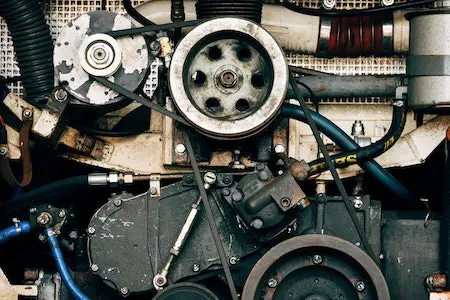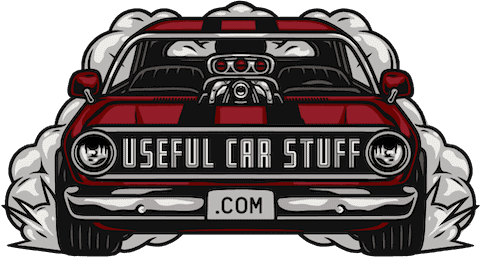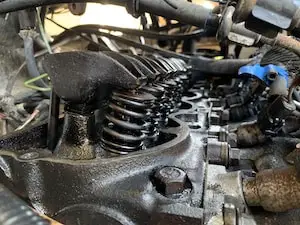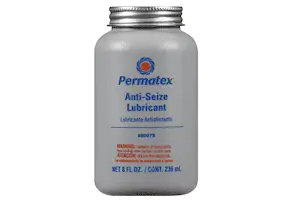There is little more annoying than starting your car and EVERY time you turn it on and roll out the driveway you alert the entire neighborhood that you are on the road because they hear the squealing belt! A squealing belt is just as bad as the scraping of chalk on the chalkboard. But not every car belt squeals, and why does mine? Here is how to fix a squealing belt.
A squealing belt is fixed in 3 ways: With either a lubricant such as a bar of soap or W-40 to moisten a dry belt, by tightening the belt, or by replacing the belt. The squealing can be caused by a dried out belt, a cracked and worn-out belt, and most commonly is a stretched or loose belt.
Inspecting the belt for signs of cracks should be the first thing you do to determine if the belt should be replaced.
But we will cover this more at the bottom of the page. Whether or not the belt needs replacing, you MUST get rid of the squeal!

Lubricant on the Belt to Stop Squeaking
Lubricating the belt with something is the number one way to stop a squealing belt.
This is most easily accomplished with the car running and applied to the belt while it is spinning.
Be VERY careful around the spinning belt and the engine fan. If you feel uncertain in any way about working on the spinning belt, do not do the repair, but take it in to a shop.
This is actually a job that is so simple that I am certain you can stop by a mechanic shop and if you request nicely, they will tighten the belt or lubricate the belt for you free of charge. I am so certain because I have done this myself. Sure I had the tools and the know-how but I was on the road and my new belt was squealing so loud I had to fix it as soon as possible.
I stopped by a random mechanic shop and asked if they would help. One of the mechanics gladly brought over a wrench and tightened up the belt for me. Now that is a shop that I am happy to recommend or bring more work to in the future.
Any good shop will do this for you and if they refuse and require money they you know that is a shop not worth taking your car to in the future and you should keep looking elsewhere.
A knowledgeable shop with decent mechanics will be more than happy to spend 35 seconds fixing a squealing belt and capture a future customer.
There are two simple effective lubricants that I am aware of that work well on a noisy serpentine belt. Soap and WD-40 and either will be a good choice.
Bar of Soap
A bar of soap is the go-to for many old-time mechanics. And is the featured old-time mechanic’s trick! This is a classic mechanics trick that goes back years. They would keep a bar of soap in the trunk or tool box just for the squeaking dried-out belt problem!
This is the perfect trick simply because it is so easy to store and keep a bar of soap in the car toolkit.
It is also cheap, easy to use, and does not make a mess. And you can pick out a scent that you like!
Take the bar of soap and lightly press it against the moving belt while the car is idling and you will hear the squeal go away instantly. If you can get the soap on the top and both sides of the belt that is best.
If the belt squealing does not stop after a thorough soaping, then you know that the problem is the belt is too loose!
WD-40
A can of WD-40 is a must have in a tool kit for its’ many applications. One of its’ many applications is to lubricate and stop a leaky belt!
A dried out and cracked belt is what causes the squealing sound (when the belt is tight enough) and can be stopped with a moist belt.
WD-40 is an easy-to-apply, readily available cheap solution to a dried out belt.
Simply spray a bit of WD-40 on the belt while the car is idling and listen to the squeal go away instantly!
Either of these two lubricants will not cause damage if there is too much applied, but usually a little goes a long way and too much WD-40 will just spray off the belt everywhere so keep it minimal.
Tighten the Belt to Reduce Noisy Slipping
After trying either soap or WD-40 to moisten the noisy belt, if the squealing has stopped you’re good to go. Problem solved.
If the squealing does not stop with a lubricant applied to the belt, then the belt is too loose and the noise is caused by the belt slipping on the pulleys.
You may notice it more often when you accelerate too. This is because the speed of the rotation of the engine speeds up quick enough that the belt doesn’t keep up but instead slips.
Most new cars have a belt tensioner assembly. There is an adjustment bolt on the tensioner that allows you to increase the tension.
Old cars do not have a tensioner but rather use an adjustment with the alternator mount. Loosen the mount, pull on the pulley or alternator till the belt is very taught and then tighten the bolts with the alternator in place.
You May have the Wrong Size Belt
If tightening the belt is not possible because you have run out of room with the tensioner or the alternator, double check the number on the belt to ensure you have the right belt.
There are MANY different sized belts and it is worth double checking since this could be the cause of your noisy squeaky obnoxious belt!
The belt size can be looked up according to the part number printed on the belt. I recommend taking the belt in or reading the part number and go in to a parts shop and have them look up this sizes and adjust accordingly if needed.
If it is old though, it is just stretched out. Go get a new one.
Replace the Belt
You can tell when to change the belt by:
Cracks in the belt = Change the Belt
No cracks in the belt = Keep the Belt
Pro Tip: If in doubt, change it out!
This is a good motto for anything rubber in your car, like hoses or belts.
It is helpful if you can find the numbers on the belt to order a new one just like it. Otherwise just pick up a new one, swap it out and away goes the squeal!


